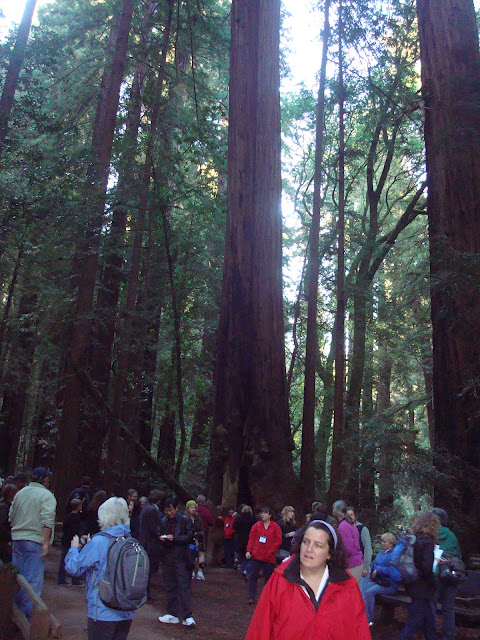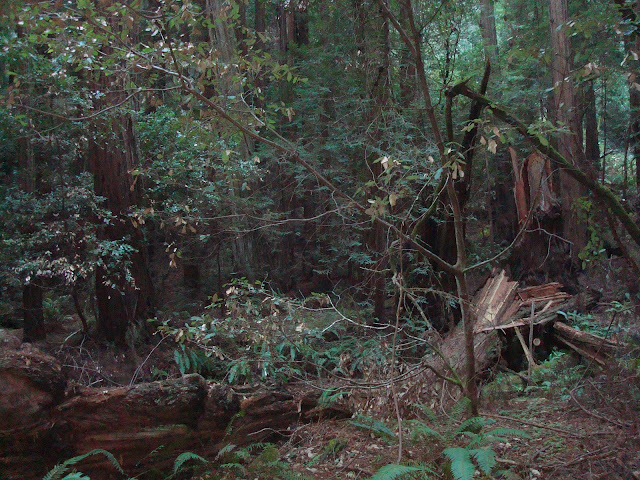Marin County.
Basically, on the this tour, we were taken to the site where Sudden Oak Death (P. ramorum) was first discovered in the United States.
"Since the early 1990s, oaks and tanoaks have been dying in the coastal counties of California. Since then, other types of plants have been found to be infected or associated with this disease, referred to as Sudden Oak Death (SOD), ramorum leaf blight or ramorum dieback. Phytophthora ramorum is the pathogen that causes these diseases. Sudden Oak Death was first reported in 1995 in Mill Valley (Marin County) on tanoak. Since that time, the pathogen has been confirmed on various native hosts in fourteen coastal California counties (Marin, Santa Cruz, Sonoma, Napa, San Mateo, Monterey, Santa Clara, Mendocino, Solano, Alameda, Contra Costa, Humboldt, Lake, and San Francisco), and in Curry County, Oregon. Through ongoing surveys, APHIS-PPQ continues to define the extent of the pathogen’s distribution in the US and limit its artificial spread beyond infected areas through quarantine and a public education program." -USDA-APHISCase Study: Sudden Oak Death /ramorum blight caused by Phytophthora ramorum
This tour included a visit to Muir Woods!
There is an abundance of information and stories that could come from Muir Woods, but the one I would like to share is that of the trees located there. The large live trees located at Muir Woods mostly consist of coastal redwoods; however, there are some scattered Douglas Firs there. The tallest coastal redwood stands 258 feet tall ("A six foot person stacked 45 times"). The average coastal redwood is 600 to 800 years old and the oldest is 1200 years old. -Now, that is old! In the understory of these magnificent trees are tanoaks.
Unfortunately, many of the tanoaks in Muir Woods are infected with Phytophthora ramorum or SOD (Sudden Oak Death). Most of the trees are dying. To a plant pathologist the story may end here. We took many pictures, so that we would have record of the symptoms of tragedy, in the hope that we can catch it before it enters our State, like Illinois. What I did not realize, is how much this disease is affecting the ecosystem of Muir woods.
Note the dark, cankers on the tanoaks, which are symptoms of Sudden Oak Death caused the the fungal pathogen, Phytophthora ramorum. For more information, go to: http://www.suddenoakdeath.org/
If the tanoaks die-then there are no acorns...
If there are no acorns, then there will be no food for the forest rats.....
If the forest rats have no food, then they could possibly die, and then the endangered spotted owls will have no food....
And so, there are many ecological studies taking place to study the many ecosystems, like this one at Muir Woods.
In most of the pictures, the browning foliage belongs to dying tanoaks in Muir Woods.
I wish I could end my story here, but the horror of it is, this fungal disease pathogen, P. ramorum, not only affects oaks, but also has been found to infect over 200 plant hosts and counting....
http://www.aphis.usda.gov/plant_health/plant_pest_info/pram/downloads/pdf_files/usdaprlist.pdf
Here is how you can prevent the spread of this pathogen to your "neck of the woods": http://www.aphis.usda.gov/publications/plant_health/content/printable_version/SBR_StopTheSpread.pdf
































No comments:
Post a Comment
Note: Only a member of this blog may post a comment.